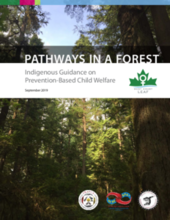Executive summary
The current child welfare system [in Canada] is sometimes referred to as “The Millennium Scoop” because of the devastatingly high rates of Indigenous children who continue to be taken into government care. Though eff orts have been made in recent years to improve the ability of the current system to support Indigenous families to remain together, the reality is that many Indigenous families continue to experience the child welfare system in the same way their ancestors have: as one that breaks up families and communities under the guise of protecting Indigenous children.
In this report, we set out the experiences of 64 parents who have had engagement with the child welfare system. Their stories and expertise provide a wealth of knowledge about the strengths and weaknesses of current prevention-based eff orts and programs. Their experiences demonstrate that, despite the Ministry for Children and Family Development’s (MCFD) emphasis on improving prevention-based services for Indigenous families, long-standing apprehension-focused practices continue to permeate the system.
The stories we heard echo the disparity between practice and policy that has been noted in numerous reports. For example, in When Talk Trumped Service: A Decade of Lost Opportunity for Aboriginal Children and Youth in BC, the Representative for Children and Youth found that, though MCFD had made broad statements in support of improving the state of the child welfare system in BC by supporting families and working more collaboratively with communities, government e fforts had not led to much concrete change in service delivery or outcomes for children and families. In this report, we have identified three broad underlying factors that are undermining the full realization of prevention-based e fforts:
- Ongoing cyclical colonialism: Many participants felt that the foundational beliefs and practices that existed in the residential school system and the Sixties Scoop continue to exist in the current child welfare system. They expressed concern that the current child welfare system is ill-equipped to address intergenerational trauma, systemic racism and marginalization, and disparities in the social determinants of health for Indigenous peoples.
- Gaps in supports and services: Despite the emphasis on improving prevention-based e fforts in the child welfare system, participants felt that there were significant gaps in the types of services that their families needed. Where services were available, there were systemic and individual barriers to accessing them.
- A lack of accountability: Project participants expressed frustration over the lack of accountability from social workers and how this led to vast discrepancies in social work practice and undermined prevention-based e fforts. The lack of accountability that is built into the current child welfare system impacts the relationship Indigenous families and social workers develop. This leads to a top-down approach in which social workers can dictate terms to parents rather than a relationship-centred approach that fosters trust and collaboration.
While there remains much work ahead for the child welfare system to be able to shift its focus from apprehending children to supporting families and communities, there are also clear pathways in the forest. The parents who participated in our project shared with us various experiences of positive supports and ideas for a way forward. We highlight some of these programs and e fforts throughout our report. We also identify three themes that underlie these promising practices:
-
Indigenous approaches to child welfare: Programs that were grounded in Indigenous child-raising knowledge were identified by parents as some of the most eff ective prevention-based programs. Indigenous Nations have long had rich child-raising practices and many communities have been undertaking e fforts to revitalize and restore this knowledge. Support for these eff orts was identified by project participants as a positive step forward.
-
Community-based supports: Localized, integrated, and wrap-around community-based programs and services were identified by almost all parents as the most e ffective form of prevention-based programming. Project participants felt that the local community was best placed to understand the family’s needs, mobilize resources, and develop creative, out-of-the-box solutions.
-
Self-determination: The parents who participated in our project felt that the future of a prevention-based child welfare system for Indigenous peoples must be rooted in self-determination. Participants firmly believed that Indigenous Nations and communities should have full authority over all decisions that impact their children.
The voices of Indigenous parents demonstrate that the child welfare system remains in need of a transformative shift and the way forward is grounded in Indigenous knowledge, driven by community-based programs, and designed to support self-determination for all Indigenous peoples.

